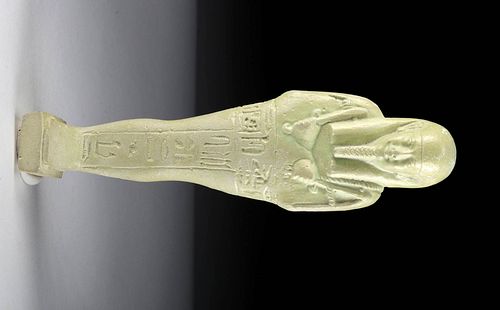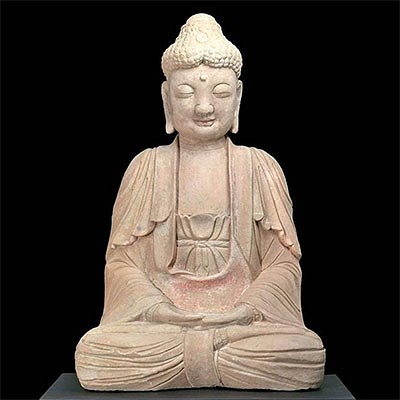Translated Egyptian Pale Green Faience Ushabti w/ TL
Lot 5a
About Seller
Artemis Fine Arts
686 S Taylor Ave, Ste 106
Louisville, CO 80027
United States
Selling antiquities, ancient and ethnographic art online since 1993, Artemis Gallery specializes in Classical Antiquities (Egyptian, Greek, Roman, Near Eastern), Asian, Pre-Columbian, African / Tribal / Oceanographic art. Our extensive inventory includes pottery, stone, metal, wood, glass and textil...Read more
Categories
Estimate:
$15,000 - $20,000
Absentee vs Live bid
Two ways to bid:
- Leave a max absentee bid and the platform will bid on your behalf up to your maximum bid during the live auction.
- Bid live during the auction and your bids will be submitted real-time to the auctioneer.
Bid Increments
| Price | Bid Increment |
|---|---|
| $0 | $25 |
| $300 | $50 |
| $1,000 | $100 |
| $2,000 | $250 |
| $5,000 | $500 |
| $10,000 | $1,000 |
| $20,000 | $2,500 |
| $50,000 | $5,000 |
| $100,000 | $10,000 |
| $200,000 | $20,000 |
About Auction
By Artemis Fine Arts
Feb 18, 2021
Set Reminder
2021-02-18 10:00:00
2021-02-18 10:00:00
America/New_York
Bidsquare
Bidsquare : Exceptional Antiquities, Asian, Ethnographic
https://www.bidsquare.com/auctions/artemis-gallery/exceptional-antiquities-asian-ethnographic-6373
Museum-worthy examples of Egyptian, Greek, Roman, Etruscan, Near Eastern, Far East / Asian, Pre-Columbian, African / Tribal, Oceanic, Native American, Spanish Colonial, Russian, Fossils, Ancient Jewelry, Fine Art, so much more! Artemis Fine Arts info@artemisfinearts.com
Museum-worthy examples of Egyptian, Greek, Roman, Etruscan, Near Eastern, Far East / Asian, Pre-Columbian, African / Tribal, Oceanic, Native American, Spanish Colonial, Russian, Fossils, Ancient Jewelry, Fine Art, so much more! Artemis Fine Arts info@artemisfinearts.com
- Lot Description
Egyptian, Late period, Dynasty XXX, 380 to 343 BCE. An exquisite faience ushabti of Nefer-ka, presenting with stunning pale blue-green hues, modeled in the characteristic form of a mummy, wrapped in a shroud and standing upright with both feet together. The hands are crossed on the chest and hold a pair of A-shaped hoes, tools necessary for agricultural work, and seed sack. The ushabti wears a tripartite wig with locks of hair indicated by incised lines. The facial features are carefully modeled and suggest the individual portrait. The narrow tressed beard is attached under the chin. Inscriptions that cover the lower part of such statuettes usually indicate the name of the ushabti's ancient owner and also contain an excerpt from Chapter 6 of the Egyptian Book of the Dead. See the translation in the extended description below. Size: 1.625" W x 6" H (4.1 cm x 15.2 cm)
Aesthetically appealing for its brilliant color and original luster, this figure was mold-made from faience, a beloved Egyptian material. The shiny surface of faience does not depend on glaze or enamel, but is due to the migration on the surface of the quartz and copper oxides contained in the paste. Fired at relatively low temperatures, about 800 to 900 degrees Celsius, these elements turn blue during the vitrification process.
THE INSCRIPTIONS
The horizontal band of hieroglyphs may be reproduced as follows: sHD wsir wn-r sS m Hw.t nfr-kA Translation: The illuminated one who is identified with Osiris, the god of the Hereafter, is named Nefer-ka. He is a wener-priest and scribe in the temple of Ptah, the cosmic creator god of Memphis.
msj As.t-rS-tj mAa-xrw Translation: His deceased mother is named Isis-resh-ty.
DISCUSSION: The owner is named Nefer-ka, whose name literally means something on the order of "His ka is beautiful;" the name of his mother translates into English as, "The goddess Isis is joyful." (2)
The tomb of Nefer-ka is suggested to have been located at Saqqara,3 the necropolis of the city of Memphis, the tradition religious center of ancient Egypt, the principal deity of which was Ptah, in whose temple Nefer-ka served as a scribe. Nefer-ka also served as a wener-priest, a cleric who presided over The Ceremony of the Opening of the Mouth, (4) which provided the deceased with the last rites. The shabtis of Nefer-ka exhibit two designs, one with a longer version inscribed with Spell VI of the so-called Book of the Dead, and those with the inscriptions arranged in the form of the letter T, as in this example. (5) The academic consensus is that Nefer-ka exercised his functions during Dynasty XXX. (6) It is interesting to note that at least one shabti of Nefer-ka has been inventoried and is listed at the website of the international inventory of known, published shabtis, maintained by the Societe d'Egyptologie, Geneva.
2 Hermann Ranke, Die Ägyptischen Personennamen (Gluckstadt, 1935), 200, nos. 16-17; and 4, no. 10, respectively.
3 Jacques-F. Aubert and Liliane Aubert, Statuettes égyptiennes. Chaouabtis—Ouchebtis (Paris, 1974), 254.
4 Aubert / Aubert 1972, 254.
5 Aubert / Aubert 1972, 254.
6 Glenn Janes, Shabtis — a private view (Paris, 2002), 223.
Overview:Beginning in the early Middle Kingdom about 2100 BCE, the ancient Egyptians believed that they were obliged to perform certain odious and distasteful tasks in the hereafter. Such tasks are more fully described in funerary texts of the New Kingdom in which the deceased is asked to move sand from one bank to another. Although enigmatic, scholars suggest that those tasks deal with the clearing of irrigation canals so vital for Egypt’s agriculture and that the work was performed by individuals who were subjected to the corvée, or forced labor. In order to avoid such work, the ancient Egyptians introduced the concept of surrogates for the deceased who, in the afterlife, were believed to perform that labor on their behalf. The shabtis themselves were believed to resent such labor with the result that the deceased was provided for 365 shabtis so that each shabti would only have to work one day each year. Still, additional shabtis called overseers, or foremen, were also included to insure the daily discharge of that obligation. (See, Harry M. Stewart, Egyptian Shabtis (Buckinghamshire, 1995), particularly 30-32.)
BIBLIOGRAPHY: AUBERT J.-F., AUBERT L., Statuettes egyptiennes: Chaouabtis, Ouchebtis, Paris, 1974; BOVOT J.-L., Chaouabtis: des serviteurs pharaoniques pour l’eternite, Paris, 2003; BOVOT J.-L., Les serviteurs funeraires royaux et princiers de l'Ancienne Egypte, Musee du Louvre, Departement des antiquites egyptiennes, Paris, 2003; NEWBERRY P.E., Funerary Statuettes and Model Sarcophagi, Catalogue general des antiquites egyptiennes au Musee de Caire 53 (2), Cairo, 1930; SCHNEIDER H.D., Shabtis: an introduction to the history of ancient Egyptian funerary statuettes with a catalogue of the collection of the National Museum of Antiquities at Leiden 1-3, Leiden, 1977.
This piece has been tested using thermoluminescence (TL) analysis and has been found to be ancient and of the period stated. A full report will accompany purchase.
Provenance: ex private Swiss colletion, ca 1980s; Private European Collection
All items legal to buy/sell under U.S. Statute covering cultural patrimony Code 2600, CHAPTER 14, and are guaranteed to be as described or your money back.
A Certificate of Authenticity will accompany all winning bids.
We ship worldwide and handle all shipping in-house for your convenience.
#162420Intact and near-choice. TL hole on base has been filled.Condition
- Shipping Info
-
All shipping is handled in-house for your convenience. Your invoice from Artemis Gallery will include shipping calculation instructions. If in doubt, please inquire BEFORE bidding for estimated shipping costs for individual items.
-
- Buyer's Premium



 EUR
EUR CAD
CAD AUD
AUD GBP
GBP MXN
MXN HKD
HKD CNY
CNY MYR
MYR SEK
SEK SGD
SGD CHF
CHF THB
THB














